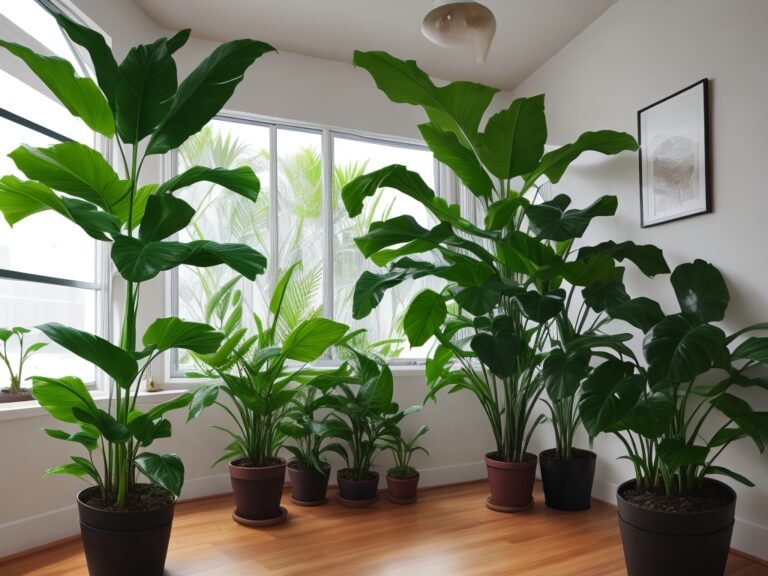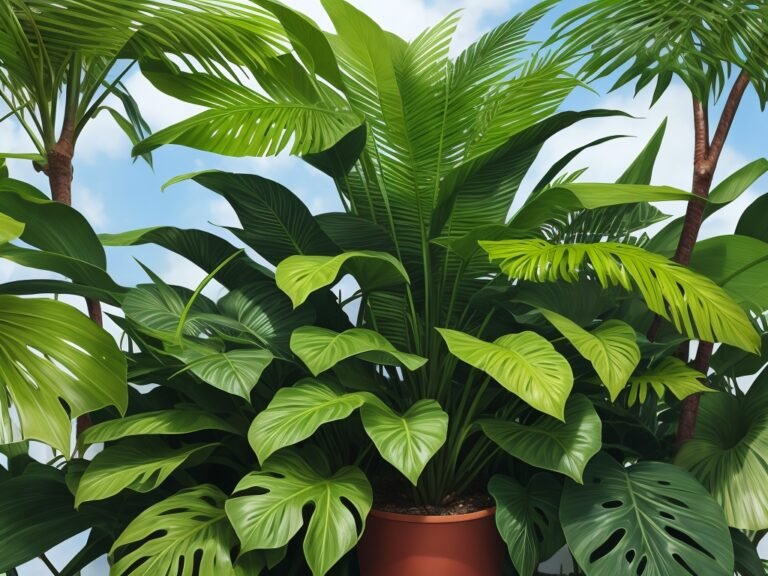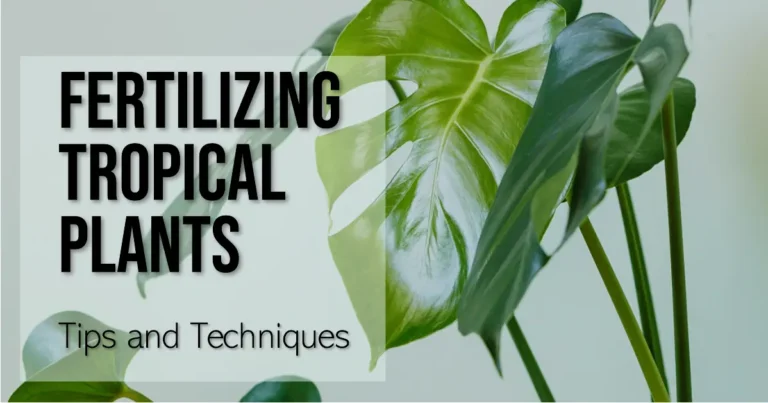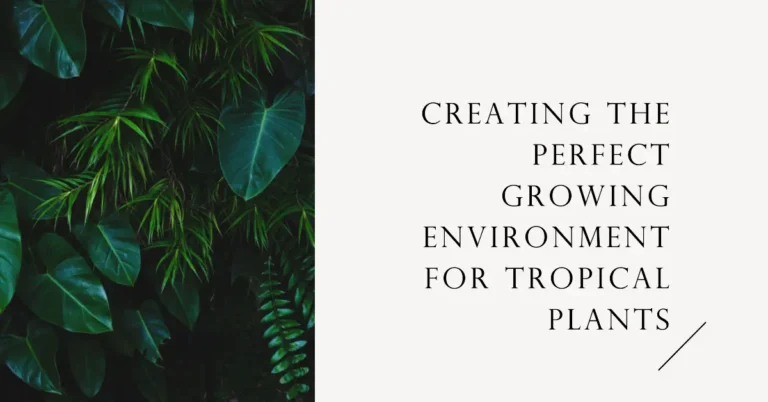Brown Leaves? Droopy Leaves? Fix Common Tropical Plant Problems
Key Takeaways:
- Adjust watering habits to prevent brown and droopy leaves in tropical plants.
- Ensure proper drainage and use well-draining soil for healthier tropical plants.
- Pay attention to humidity levels and provide misting or a humidifier as needed.
- Monitor light exposure and adjust positioning to maintain optimal conditions for tropical plants.
Do you ever look at your beloved tropical plants and wonder why their leaves are turning brown or drooping?
It can be frustrating and disheartening to see your once vibrant and lush plants suffering.
But fear not! I am here to help you fix these common tropical plant problems.
In this article, I will delve into the causes of brown leaves, droopy leaves, yellow leaves, and curling leaves, and provide you with practical tips on how to revive your plants.
Get ready to learn about proper watering techniques, the importance of adequate lighting and humidity control, and how to prevent pesky pests from wreaking havoc on your tropical oasis.
Say goodbye to wilted leaves and hello to thriving greenery!
| Problem | Cause | Solution |
|---|---|---|
| Brown Leaves | Root rot, overwatering, inadequate drainage | Check drainage, reduce watering, repot if necessary |
| Droopy Leaves | Underwatering, heat stress | Water thoroughly, provide shade or mist regularly |
| Yellow Leaves | Root problems, nutrient deficiency | Check soil moisture, fertilize with balanced fertilizer |
Common Tropical Plant Problems
Tropical plant problems are common and can include issues like brown leaves, droopy leaves, yellow leaves, and curling leaves. Let’s explore the causes and solutions for each.
Brown Leaves
Brown leaves on tropical plants can be caused by various factors, such as inadequate watering, improper lighting, low humidity, or pest infestation.
To fix brown leaves, make sure to water your plants correctly, provide adequate lighting, maintain proper humidity levels, and prevent pest infestations.
Causes of brown leaves
Brown leaves on tropical plants can be caused by a few different factors.
One common reason is inadequate watering, either too much or too little.
Another possibility is insufficient lighting, as tropical plants need bright, indirect light to thrive.
Additionally, extreme temperatures or exposure to drafts can lead to leaf discoloration.
Finally, nutrient deficiencies or pest infestations can also cause leaves to turn brown.

How to fix brown leaves
To fix brown leaves on your tropical plant, you should first identify the cause.
It could be due to underwatering, overwatering, direct sunlight, or nutritional deficiencies.
Adjust your watering schedule, provide proper shade, and fertilize your plant if necessary.
Trim off the brown leaves and monitor your plant’s progress.
Droopy Leaves
Droopy leaves on tropical plants can indicate a few different issues. It’s usually a sign that the plant is not getting enough water or is being overwatered.
Make sure you’re watering correctly and adjusting as needed.
Other possible causes include inadequate lighting or low humidity. Check these factors and make adjustments accordingly.
Causes of droopy leaves
Droopy leaves in tropical plants can be caused by a variety of factors.
Overwatering is a common culprit, as it can lead to root rot and poor oxygen circulation.
Underwatering can also cause drooping leaves, as the plant becomes dehydrated.
Lack of adequate light can result in weak and droopy foliage.
Furthermore, environmental factors such as cold drafts or extreme temperatures can cause leaves to droop.
It’s essential to identify the specific cause of droopy leaves to provide the appropriate solution.
How to fix droopy leaves
To fix droopy leaves in your tropical plant, there are a few steps you can take.
First, check the soil moisture and make sure it’s not too dry or too wet.
Adjust watering accordingly.
Next, assess the lighting conditions and ensure your plant is getting enough bright, indirect light.
Additionally, consider the humidity levels in your home and provide a humidifier or place your plant near a tray of water.
Finally, inspect for pests and treat as necessary.
These steps should help revive your plant’s droopy leaves.
Yellow Leaves
Yellow leaves on tropical plants can be caused by various factors, including overwatering, inadequate light, nutrient deficiencies, or pest infestations. To fix yellow leaves, ensure proper watering techniques, provide adequate lighting, fertilize regularly, and prevent pest attacks.
Causes of yellow leaves
Yellow leaves in tropical plants can be caused by various factors, including overwatering, underwatering, nutrient deficiencies, or exposure to extreme temperatures.
Lack of sunlight or improper lighting can also lead to yellowing leaves.
It’s important to identify the specific cause and adjust watering, lighting, and nutrient levels accordingly.
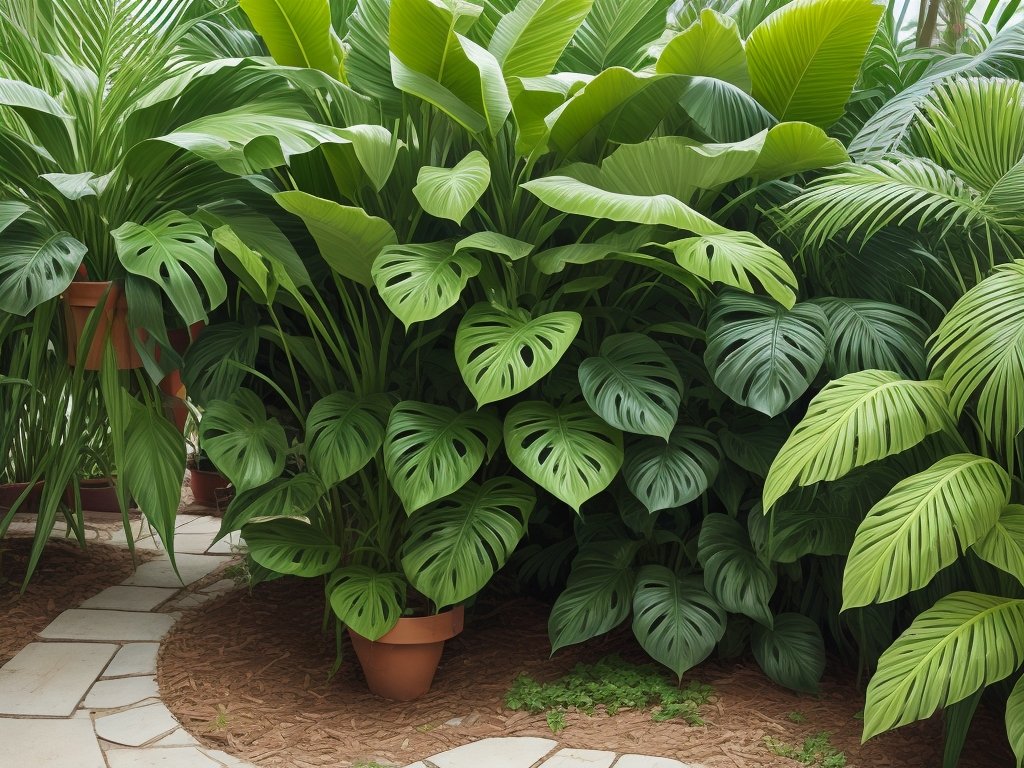
How to fix yellow leaves
To fix yellow leaves on your tropical plant, start by identifying the cause.
Some common causes include overwatering, underwatering, nutrient deficiencies, or inadequate lighting.
Adjusting your watering schedule, ensuring proper drainage, providing balanced fertilizer, and placing your plant in a bright location can help restore healthy green leaves.

Curling Leaves
Curling leaves in tropical plants can be caused by several factors.
Overexposure to direct sunlight or extreme temperatures, lack of moisture, and nutrient deficiencies are common culprits.
To fix curling leaves, ensure proper watering, provide shade, maintain consistent temperatures, and fertilize your plants regularly.
Causes of curling leaves
Curling leaves in tropical plants can be caused by various factors such as underwatering, overwatering, temperature stress, pests, or nutrient deficiencies. Lack of moisture can cause leaves to curl inward, while excess water can lead to root rot and curling.
Extreme temperatures or pest infestations can also result in curling leaves.
Nutrient deficiencies, specifically in micronutrients like magnesium or iron, can also contribute to leaf curling.
How to fix curling leaves
To fix curling leaves on tropical plants, first, check the soil moisture. Overwatering or underwatering can lead to curling.
Adjust watering accordingly.
Next, ensure adequate humidity levels, as low humidity can cause leaf curl. Mist the leaves or use a humidifier.
Lastly, examine the plant for pests.
Insect infestations can also result in curling leaves. Treat any pests with appropriate methods.
Preventing Common Tropical Plant Problems
To prevent common tropical plant problems, it’s important to focus on proper watering techniques, adequate lighting, humidity control, and pest prevention.
Proper Watering Techniques
Proper watering techniques are essential for maintaining the health of your tropical plants.
Here are some tips: 1) Water your plants when the top inch of soil feels dry.
2) Use room temperature water to avoid shocking the roots.
3) Water thoroughly until water drains from the bottom of the pot.
4) Avoid overwatering, as it can lead to root rot.
5) Consider using a moisture meter to gauge moisture levels.
6) Adjust your watering frequency based on the season and humidity levels.
Just specific needs of your tropical plantst excessively, to keep your tropical plants happy and thriving.
Significance of watering correctly
Proper watering is crucial for the health of tropical plants.
It ensures they receive the right amount of moisture essential for growth.
Underwatering can lead to wilting and stunted growth, while overwatering can cause root rot.
Consistent and balanced watering promotes healthy foliage, vibrant blooms, and overall plant vitality.
Tips for watering tropical plants
It’s important to water tropical plants properly to keep them healthy.
Here are some tips:
- Check the soil moisture before watering to avoid overwatering. Stick your finger about an inch into the soil – if it feels dry, it’s time to water.
- Water deeply but infrequently. Give the plant a thorough soaking, allowing the water to reach the roots, and then wait until the top inch of soil feels dry before watering again.
- Use room temperature water to avoid shocking the roots. Cold water can cause stress to the plant.
- Don’t let the plants sit in standing water. Make sure the pot has good drainage so excess water can escape.
- Adjust watering frequency based on seasonal changes. Plants may require less water during colder months.
Remember, watering is just one part of plant care.
Observing your plants and adjusting watering practices based on their specific needs will help them thrive.
Adequate Lighting
Adequate lighting is crucial for tropical plants to thrive. They need bright, indirect sunlight to grow properly.
Place them near a window with filtered light or use fluorescent grow lights.
Avoid direct sunlight, as it can scorch their leaves. Regularly check the lighting conditions to ensure your plants are getting the right amount of light.
Importance of proper lighting for tropical plants
Proper lighting is crucial for tropical plants because it directly affects their growth and overall health. Tropical plants typically thrive in bright, indirect light, mimicking their natural habitat.
Insufficient light can lead to stunted growth, pale leaves, and weak stems.
On the other hand, too much direct sunlight can scorch their leaves. Find the right balance to ensure your tropical plants flourish.
Tips for providing adequate lighting
Adequate lighting is crucial for the health of tropical plants. Here are some tips to ensure they get the right amount of light:
- Place your plants in an area that receives indirect sunlight. Direct sunlight can scorch the leaves.
- If your plants don’t get enough natural light, consider using artificial grow lights. LED grow lights are a popular choice as they mimic the sun’s spectrum.
- Rotate your plants regularly to ensure all sides receive equal exposure to light. This helps prevent them from growing lopsided.
- Keep your plants away from drafts or windows with extreme temperature fluctuations, as this can stress them out.
- Observe your plants closely. If you notice signs of light deficiency (such as elongated stems or pale leaves, increase the amount of light they receive.
Remember, different plants have different light requirements, so it’s essential to research the specific needs of your tropical plants.
Humidity Control
Proper humidity control is essential for tropical plants.
High humidity promotes healthy growth, while low humidity can lead to dryness and stress.
To maintain ideal humidity levels, you can use a humidifier, place plants on trays filled with water, group plants together, or mist them regularly.
It’s important to monitor humidity levels regularly to ensure your plants thrive.
Impact of humidity on tropical plants
Humidity plays a crucial role in the health of tropical plants. High humidity helps them thrive, as it mimics their natural environment.
It keeps their leaves hydrated, prevents wilting, and encourages proper growth.
However, low humidity can lead to dry leaves, browning, and even plant stress. Maintaining proper humidity levels is essential for the overall well-being of tropical plants.
Tips to maintain proper humidity levels
Maintaining proper humidity levels for tropical plants is essential for their health and well-being.
Here are some tips to help you keep the humidity just right:
- Grouping plants: Place your plants together to create a microclimate with higher humidity levels.
- Using a humidifier: Invest in a humidifier to increase moisture in the air, especially during dry seasons.
- Misting the leaves: Regularly misting your plant’s leaves with room temperature water can help increase humidity around them.
- Pebble tray: Place a shallow tray filled with water and pebbles beneath your plants. As the water evaporates, it will add humidity to the surrounding air.
- Avoiding drafts: Keep your plants away from drafty areas like windows or doors, as these can decrease humidity levels.
Remember, maintaining proper humidity levels can greatly benefit your tropical plants and help prevent common problems.
Pest Prevention
Pest prevention is crucial for keeping your tropical plants healthy. Here are some tips to keep pests at bay:
- Inspect your plants regularly for signs of pests, such as webs, holes, or wilting leaves.
- Keep your plants clean by regularly removing dead leaves and debris.
- Avoid overwatering, as excessive moisture can attract pests.
- Use natural pest control methods, such as neem oil or insecticidal soap, to treat any infestations.
- Quarantine new plants before placing them with your existing ones to prevent introducing pests.
Remember, staying vigilant and taking proactive measures can help protect your tropical plants from pests.
Common pests affecting tropical plants
Common pests that commonly affect tropical plants include aphids, mealybugs, spider mites, and scale insects. These pests feed on the plant’s leaves, sucking out the sap and damaging the foliage.
They can also transmit diseases.
To prevent pest infestations, regularly inspect your plants, keep them clean, and use organic pest control methods such as neem oil or soapy water.
Tips for preventing pest infestations
To prevent pest infestations in your tropical plants, here are a few tips to keep in mind:
- Regularly inspect your plants for any signs of pests, such as webs, holes, or chewed leaves.
- Quarantine new plants before introducing them to the rest of your collection to prevent spreading any potential pests.
- Keep your plants clean by regularly wiping off dust and debris from their leaves.
- Avoid overwatering your plants, as excessive moisture can attract pests.
- Provide proper ventilation to promote airflow and discourage pest infestation.
- Use organic pest control methods, such as neem oil or insecticidal soap, to treat any infested plants.
- Consider introducing beneficial insects, like ladybugs or predatory mites, to help naturally control pest populations.
- Avoid overcrowding your plants, as dense foliage can create a breeding ground for pests.
Frequently Asked Questions
Why are my tropical plant’s leaves turning brown?
Tropical plant leaves usually turn brown due to either over or underwatering, improper lighting, low humidity, or pest infestations.
Lack of proper care can lead to stress and cause the leaves to wither and change color.
It’s important to address these issues promptly and make necessary adjustments to ensure the health and well-being of your tropical plants.
What causes droopy leaves in tropical plants?
Droopy leaves in tropical plants are usually caused by overwatering or underwatering. If the soil is too wet, it can lead to root rot and the roots can’t absorb enough oxygen, causing the leaves to droop.
On the other hand, if the soil is too dry, the plant can’t get enough water and the leaves can become wilted.
Proper watering and finding the right balance is key to preventing droopy leaves in tropical plants.
How do I fix yellow leaves on my tropical plant?
To fix yellow leaves on your tropical plant, start by checking the watering.
Make sure you’re not overwatering or underwatering, as both can cause yellowing.
Provide adequate light and humidity for your plant’s needs.
Trim off any severely damaged leaves and monitor for pests.
Adjusting these factors should help restore your plant’s health.
Why are my tropical plant’s leaves curling?
Leaves on tropical plants can curl due to several reasons. It could be a sign of underwatering, overwatering, or improper humidity levels.
Curling can also be caused by pests, nutrient deficiencies, or temperature extremes.
Identifying the specific cause will help in finding the right solution to fix the issue.
How often should I water my tropical plant?
Water your tropical plant when the top 1-2 inches of soil feel dry.
Stick your finger into the soil to check the moisture level.
Ensure that you water thoroughly, allowing excess water to drain out.
Avoid overwatering, as it can lead to root rot.
How do I provide adequate lighting for my tropical plant?
To provide adequate lighting for your tropical plant, place it in a location where it can receive bright, indirect sunlight. Avoid placing it in direct sunlight as it can scorch the leaves.
If natural light is limited, you can also use artificial grow lights specifically designed for plants.
Make sure to position the grow lights at the appropriate distance to prevent burning or damage to the plant.
How do I control humidity for my tropical plants?
To control humidity for your tropical plants, you can use a few strategies.
One option is to mist the leaves with water to increase moisture in the air.
Another method is to place a tray filled with water near the plants to increase humidity naturally.
Lastly, you can use a humidifier to regulate and maintain the desired humidity level.
Final Verdict
Brown and droopy leaves are common problems faced by tropical plant owners, but they can be easily addressed with the right knowledge and care.
Brown leaves can be caused by various factors such as overwatering, nutrient deficiencies, or too much direct sunlight.
Droopy leaves, on the other hand, can be a result of underwatering or inadequate lighting.
By understanding the causes and implementing appropriate solutions, such as adjusting watering schedules, providing sufficient light, and maintaining proper humidity, these issues can be resolved.
It is also important to be proactive in preventing pest infestations by regularly inspecting plants and practicing good hygiene.
With these tips, you can keep your tropical plants healthy and thriving.


